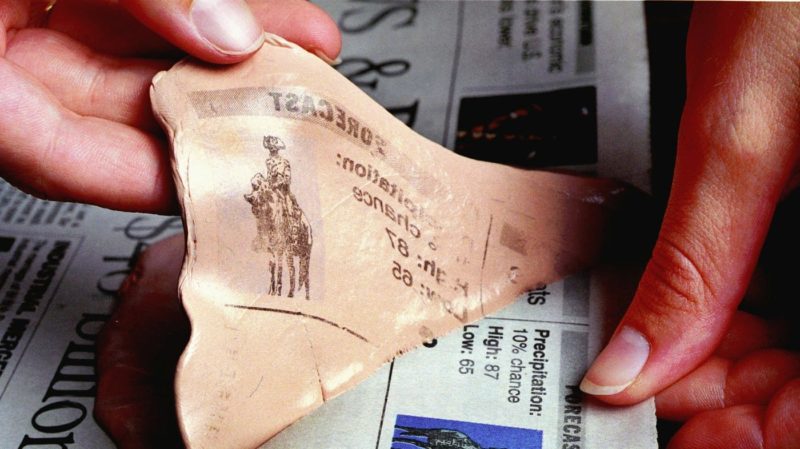The Accidental Brilliance of Silly Putty

Here’s the word of the day: viscoelastic. It is a substance that seems solid but slowly drips into a puddle over time. The same substance if pulled quickly snaps and breaks.
As part of continuing studies of what happens if Antarctica melts, scientists have begun to test the possibility that polar ice caps are more viscoelastic than they previously believed. This means that by century’s end, Boston might not be underwater. Instead, this melting might make very little difference at all.
But this article isn’t about ice caps. It’s about another gloriously viscoelastic substance: Silly Putty. We loved it as kids. I have an early memory of getting in big trouble for sticking some on a church pew. The whole phenomenon is curious. How is it that this seemingly ridiculous stuff could become a product that links the generations?
A closer look reveals that you can learn so much about the way the world works just by looking at the history of this pliable plaything. The story reinforces the point of Pete Earle and Sean Smith: “innovation rarely (and despite all appearances) follows a pre-ordained path, but rather it progresses in fits and starts, inevitably and invariably bending to the feedback and the will of the marketplace.”
Who invented it? There are several competitors for the title, and at least two patents. Earl L. Warrick, who died in 1992, always claimed that he and a colleague at Dow Corning, Rob Roy McGregor, invented it in 1943. But the claim is so uncertain that Warrick’s New York Times obituary even hedged. It appears that James Wright, who was a researcher at General Electric, also has a claim and a patent dated from 1944 to prove it.
More likely, it is a case of simultaneous invention. It turns out that this is not unusual in human history. It is actually the norm. In fact, if you look at the history of just about anything from the cotton gin to the telephone to flight itself, you find a raging dispute over who was first. Patents settle nothing: the bureaucrats approving those items mix things up constantly, and much depends on how the lawyers write them.
Lesson No. 1: The legend of the lone inventor in his lab is a myth. We all breathe the same air of ideas. Those ideas get mixed and remixed. Researchers in the history of invention have found that innovations occur on the margin and simultaneously over large parts of the world, a bit of improvement here and there, all stemming from trial and error and the targeted purpose of the product. This applies not only to products, but also to ideas.
To freeze one stage and isolate one inventor with a government monopoly grant of privilege (the patent) is wholly artificial and injurious to the process of discovery. This is why the lawsuits by Apple against Samsung (among a million other wasteful patent lawsuits) are so pointless. Everyone “steals” from everyone else, except that it is not stealing to learn from others, adapt, improve, remix. That’s how society advances.
In any case, the scientists who discovered the initial putty imagine revolutionary uses for the new rubber substitute. No one ever found such a use, unless you include the desire to make a quick and rubbery copy of your favorite Sunday comic. The main use of this stuff turns out to be pretty much what it was in the lab: a fun thing to play with.
Lesson No. 2: No man is smart enough to foresee the most highly valued economic contribution of any good or service. We think we know, but we do not. The only way to discover economic value is to put something out there in the marketplace and see what happens. Most of the time, we are surprised.
Silly Putty languished in the world of labs and science until the owner of a toy store in New Haven, Conn., Ruth Fallgatter, saw some potential and put it in the catalog. It was a smash hit, selling millions, for adults at first and later to kids. Even then, Ruth didn’t quite see the possibilities here. It took the marketing executive that she hired, Peter C. L. Hodgson, to push it to the limit and become the first Silly Putty millionaire.
It wasn’t easy, however. Everyone told Hodgson that he was crazy, that this stupid stuff had no use. He forged ahead in any case, making more millions in the early fifties. Then the Korean War nearly shut him down with its rationing of essential ingredients. Still, after the war, he persisted and adapted to the changing market.
Lesson No. 3: Invention is never enough. You need marketing to make something wonderful and change the world. Nothing sells itself. You can invent the greatest food, drink, drug or shoe in the history of the world, but it will languish unless there is someone around to take the risk to get it to market. In the course of this marketing, the product often changes. Invention is overrated; marketing is underrated. And even when there is a successful push, it still takes a special entrepreneurial mind to see a possible future of continued success.
By the 1960s, Silly Putty was huge, a massive seller all over the world. It was the classic case of a fad gone wild, except for one thing. It wasn’t a fad. This stuff continues to be an integral part of the cultural experience, generation after generation. In fact, consider this: how many consumer products that you know have been largely unchanged for 50 years and yet still sell millions per day?
Lesson No. 4: Nothing can be dismissed a priori as a fad, and nothing can be declared a priori as a valuable item destined to be a classic. There is no way to know for sure. This is because what we call value is ultimately bound up with the individual human mind. Value is subjective, as the Austrian economists say. We make value by our thinking, and our thinking is notoriously unpredictable. What is useless and what is useful is bound up with human experience. No one can know in advance, which is one reason that central planning is impossible.
Peter Hodgson, the world’s great champion of this stuff, a man whose whole life was dedicated to selling a stretchy, bouncy substance, died in 1976. The next year, the product and the marketing apparatus was taken up by the same company that sells Crayola crayons. It remains an amazing success, unchanged from its long tradition.
Lesson No. 5: Corporate takeovers do not spell disaster. They are sometimes the best means for preserving a tradition and taking it to a new level. It all depends. In the case of this one product, Silly Putty has been an amazing seller for decade after decade. Even for huge corporations, the rule still applies: If it isn’t broken, don’t fix it.
Looking from the outside in, taking on the role of a dictator who knows what we need and what we don’t, one would never say that Silly Putty was an essential contributor to life just because, for some odd reason, we are intrigued by its capacity for both bouncing and stretching.
And yet there it is — a staple of civilization as we know it. And why? It makes us happy. That’s a good enough reason.
Overall, the success of this product should humble us into questioning what we think we know for sure, and, further, introduce doubt about the ability of intellectuals and planners perfectly to anticipate and control the world. Ahem, this has implications for grandiose climate change models.
As it turns out, Silly Putty has another use: as a metaphor to show us that sea levels might not rise and swallow up great cities. Chalk up another achievement to this mysterious and brilliant substance that we just can’t stop buying.












